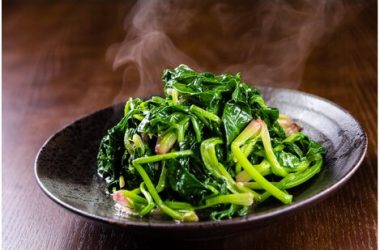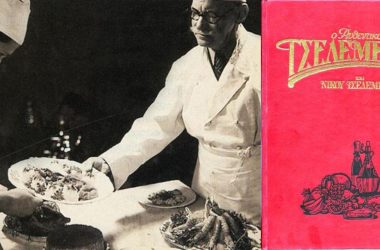
Disclaimer: Today’s article is brought to you by the writers of “Moussaka – A Truly Not Greek Dish.” The saga continues. We advise our readers to bring a cup of coffee or hot tea and enjoy the story.
For those of you who have read our previous article, Moussaka – A Truly Not Greek Dish, you will find out how Anthea and Ashraf’s date ended. Let’s just say, moussaka was not the end of their story.
As for those of you who are unfamiliar with it, we advise you to first read the story here and then proceed with the current article because spoilers have never done anyone any good. If you are from the latter and are still stubborn enough to keep on reading, this is your cue to change your mind before proceeding at your own risk.

TIME FOR DESSERT
When we last left our heroes, Anthea had just discovered that moussaka was not a uniquely Greek dish. Her distraught features gazed up at Ashraf, and while still rigid in her chair, she asked the waiter for a coffee. “There is nothing a little coffee can’t fix,” she said with a smile as the waiter was leaving the table.
The waiter, on the other hand, had schemed a devious plan. He rubbed his hands together in excitement, fixed his fustanella, and with a cheerful step crossed the swinging doors to the kitchen.
He poured dark aromatic coffee into the cups and reached to a box, covered in a fine dust of powdered sugar. Egyptian, my foot, the waiter thought as he grabbed small gelatinous cubes and arranged them on a beautiful plate with a golden rim. I will give him the best dessert Greece has to offer. He stepped out of the kitchen with the tray in hand, an aura of confidence following his every move.

Anthea smiled when she saw the waiter coming around the table and followed his hands with attention as he served their coffee and a plate full of strange-looking cubes.
“In Greece, it is common to get dessert with your coffee,” she said to Ashraf. “This is loukoumi,” she continued, taking one of them in her hand.
“I know.” Ashraf nodded. “I grew up with those.” He took one in turn.
The waiter silently gasped, as did the other guests in the restaurant. It was as if everyone sensed some disturbance in the air, and the sirtaki music came to a halt. The loukoumi dropped with a noisy clatter from Anthea’s hand.
“Loukoumia, too?” she crooned.
“You mean malban? Yes, we have them in Egypt.” Ashraf laughed. “Ours are made from grape molasses, however.” He leaned back in his chair and took a hearty bite into the sugary loukoumi.
The waiter sighed and left the table in defeat.

GREEK DELIGHT
Loukoumi, lokum, Turkish delight, or malban are all names for the same dessert – a gelatinous cube made from a mixture of starch, sugar, sweetened water, and food colouring. The rubbery textured dessert has a unique taste, and it is popular throughout Greece.
Loukoumia (the plural of loukoumi) or Greek delight is usually served with a cup of steaming coffee or a glass of ouzo. If you pay an unexpected visit to a Greek household, it is almost certain that you will be offered the pillowy bite, covered in powdered sugar. They used to be offered in Greek cafés as a complimentary treat to the dark brew. Even though Greek delight is not commonplace nowadays, it’s still a fundamental part of Greek cuisine and remains a beloved treat in Greek homes.
Loukoumi is traditionally hand-made. The Greek recipe uses simple ingredients such as cornflower, sugar, and corn syrup, and does not use any artificial ingredients or preservatives. Yet, the preparation of loukoumi is a lengthy job.
The maker usually starts early in the morning by separating the materials in the right proportions and lighting the fire, which must not be too strong. While cooking, he must continue to stir the mix, which can last for several hours. Due to the laborious process, it must be done by at least two people. A single person cannot cope alone.
After the dessert is cooked, it is poured into wooden moulds where it stays to cool off. On the next day, it is cut into small pieces and sprinkled with powdered sugar. Loukoumia are then inserted into boxes and ready for consumption.

THE ORIGINS OF LOUKOUMI
By now, you must have said to yourself: “But how is that any different from Turkish delights? Does that mean that Turkish delight is Greek? Or vice versa?” We have the answers you seek…
If you were to take a stroll at the Grand Bazaar in Istanbul, Turkey, the vendors will tell you that Turkish delight is Turkish. So far, so good. But they will also tell tourists how the yellow, green, and red variety, covered in powdered sugar, is the original style produced during the Ottoman times. The other variety, they will say, with a clear colour, usually with pistachio or hazelnuts and often rolled in shredded coconut, is a modern invention of the Republic era.
Although it sounds believable, no one knows for sure if that is indeed the truth. The same goes for the origin of Turkish delight which remains controversial. Some claim that it dates to a drug, created by the Babylonians, 2000 years before our era, while others believe that it’s an adaptation of a Persian gum.
The most popular version of the tale is that we owe the current look of loukoumi to a Turkish candy confectioner, named Haci Bekir. In the late 18th century, he started a confectionery in Istanbul – Ali Muhiddin Haci Bekir. He developed the recipe for the Ottoman Palace, but the treat became successful and popular across the entire Empire. His confectionery is still alive today, run by the fifth generation of his descendants.

WHERE DOES LOUKOUMI’S NAME COME FROM?
Where does the name come from then? The Turkish name (lokum) comes from the Arabic, rahat-ul hulkum, which translates to “soothing the throat.” The word was then abbreviated to rahat lokum and later to lokum.
The name “Turkish delight,” however, evolved in the 18th century when an English traveller took home some of Bekir’s produce to his relatives. Hence the name – Turkish delight. Four centuries later, the UK citizens have turned the traditional Turkish delight into an almost unrecognisable treat.
At university, where stress levels are high and fast food is cheap, it’s easy to reach out for the comfort blanket sugary treats provide. So, it comes as no surprise that statistics show UK students often seek comfort in sweets offered by Cadbury such as Cadbury’s Dairy Milk. Amongst the Dairy Milk, one can also find Cadbury’s Dairy Milk Turkish Delight. This goes to show just how deeply a treat of Turkish origins has found its way to the hearts of westerners.

NARNIA IS DOOMED: HOW POPULAR CULTURE FAILED TURKISH DELIGHTS
We now know that Turkish delight became popular in Western Europe shortly after its invention. Nevertheless, it took a few decades for it to gain the same attention in the US. The 1950 fantasy novel, “The Lion, the Witch and the Wardrobe”, written by C. S. Lewis, a British writer, provides the first description of Turkish delight in popular culture.
In the book, Edmund Pevensie betrays his siblings for the delight. Not surprisingly, sales of Turkish delight increased in the US following the theatrical release of the film adaptation in 2005. The book is what brought the sweet to most Americans’ attention. Excited about the enchanted dessert, many Americans have overstated its flavour, mostly because of its description which reads like this:
“… instantly there appeared a round box, tied with green silk ribbon, which, when opened, turned out to contain several pounds of the best Turkish Delight. Each piece was sweet and light to the very centre and Edmund had never tasted anything more delicious.” – C.S. Lewis
However, as it turns out, the flavours of Turkish delight are unfamiliar to American palates. What kind of candy is worth betraying your family for? That is the question Jess Zimmerman asked, and the answers varied from vanilla fudge and layers of marshmallows, to fried dough, coated in honey.
Many Americans were surprised when they found that what they imagined has nothing to do with the real taste of Turkish delight. That is because the classic flavours of rosewater and pistachio are not common in American cuisine, and its chewy and sticky texture is found to be rather polarising. What remains certain to them is that Edmund’s willingness to betray his family for the delight is both morally and gastronomically suspect.

LONG LIVE THE GREEK DELIGHT!
Loukoumi arrived in Greece in the early 19th century and quickly became a part of the country’s gastronomic and social culture. Currently produced all over the country, the most famous loukoumia, such as Patrina loukoumia, are from the island of Syros.
“Come on, buy the original loukoumi of Syros,” is what white-dressed loukoumatzídes (loukoumi sellers) shout when entering the island’s port. The recipe for the sweet travelled with refugees from Chios to Syros around 1824, during the Greek War of Independence. Those refugees were not only carrying the recipe for the tasty treat, but also the flavours of their home, i.e. mastic and rosewater.
Loukoumi production began on Syros in 1832 and gradually gained such popularity that it reached royal houses all over Europe and even Japan. Nevertheless, in its homeland of Greece, loukoumi was never a luxury item. Quite the opposite, it could be found in the lunch pails of workers and it was often present at weddings, funerals, and memorial services on the island.
DIFFERENT TYPES OF LOUKOUMIA
It is worth mentioning, however, that there are variations of loukoumi found all over Greece. Akanés is a variation made in Serres and it has a distinct butter taste as it’s flavoured with goat’s milk butter rather than fruit essences.
There is also moustoloukouma which is made with grape must that gives it its distinct caramelised aroma. It is typically found in Volos, a seaside town in central Greece.
Soutzouk loukoum from Komotini is another fun variation. Shaped like a sausage (hence, the name), it is made by stringing walnuts on a long thread, which is then dipped into the loukoumi mixture and hung to dry. Once set, the outside is dusted with sugar to further make it look like cured meat.
The only protected geographical indication (PGI) for the lumps of delight is the name Λουκούμι Γεροσκήπου (Loukoumi Geroskipou), made in Geroskipou, Cyprus.
Another famous loukoumi is the one from Phini which is known all around Cyprus and abroad.

WHAT DO PICASSO, NAPOLEON, AND WINSTON CHURCHILL HAVE IN COMMON? TURKISH DELIGHT!
Even though Turkey is credited with the invention of Turkish delight, it can be said that the Balkan Peninsula is its homeland. These lumps of delight are present in Romania, Moldova, Bulgaria, Albania, Former Yugoslavia (Serbia, Croatia, Bosnia and Herzegovina, Montenegro, North Macedonia, and Slovenia) and of course, Greece.
Therefore, Turkish delight does not have a single author. Rather, it has been created, dismantled to its components, and rebuilt again throughout the centuries. As a result, the delight takes on many forms and flavours – each unique to their regionality and each screaming: “We are one!”














